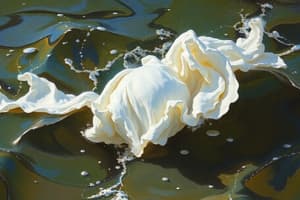Podcast
Questions and Answers
What is the primary difference between high viscosity and low viscosity fluids?
What is the primary difference between high viscosity and low viscosity fluids?
- High viscosity fluids resist flow, while low viscosity fluids flow easily. (correct)
- High viscosity fluids flow easily, while low viscosity fluids are thick.
- High viscosity fluids have a lower mass compared to low viscosity fluids.
- High viscosity fluids are less dense than low viscosity fluids.
Which factor does NOT influence the viscosity of a fluid?
Which factor does NOT influence the viscosity of a fluid?
- Color (correct)
- Temperature
- Density
- Pressure
What is the purpose of Pascal's Law in hydraulic systems?
What is the purpose of Pascal's Law in hydraulic systems?
- To establish how fluids transfer heat.
- To describe how fluids evaporate.
- To define the relationship between mass and volume in fluids.
- To explain how pressure applied to a fluid is transmitted equally in all directions. (correct)
What is the formula used to calculate the density of a substance?
What is the formula used to calculate the density of a substance?
Why is it generally more favorable to have an oil spill on land than on water?
Why is it generally more favorable to have an oil spill on land than on water?
Flashcards
Fluid
Fluid
A substance that can flow and take the shape of its container.
Density
Density
Mass per unit volume of a substance, often expressed in kg/m³.
Viscosity
Viscosity
A measure of a fluid's resistance to flow; high viscosity means thicker fluids.
Buoyancy
Buoyancy
Signup and view all the flashcards
Hydraulic System
Hydraulic System
Signup and view all the flashcards
Study Notes
Definitions
- Fluid: A substance that can flow and take the shape of its container.
- Density: Mass per unit volume. Measured in kg/m³ or g/cm³.
- Viscosity: A fluid's resistance to flow. Higher viscosity means more resistance.
- Buoyancy: The upward force exerted by a fluid that opposes the weight of an immersed object.
- Positive buoyancy: The upward buoyant force is greater than the object's weight, causing the object to float.
- Negative buoyancy: The downward force of gravity is greater than the upward buoyant force, causing the object to sink.
- Neutral buoyancy: The upward buoyant force and the downward force of gravity are equal, causing the object to remain suspended.
- Volume: The amount of space occupied by a substance. Measured in m³ or cm³.
- Mass: The amount of matter in a substance. Measured in kg or g.
- Weight: The force of gravity acting on an object. Measured in Newtons.
- Pascal’s Law: A change in pressure at any point in an enclosed fluid at rest is transmitted equally and undiminished to all points in the fluid.
- States of Matter & Particle Orientation:
- Solids: Particles are tightly packed in a fixed arrangement.
- Liquids: Particles are close together but can move past each other.
- Gases: Particles are widely spaced and move freely.
Body Fluids
- Blood: Transports oxygen, nutrients, and waste products throughout the body.
- Lymph: Part of the immune system, collects and transports fluid from tissues.
Viscosity
- High Viscosity: High resistance to flow. Honey is an example.
- Low Viscosity: Low resistance to flow. Water is an example.
Factors Affecting Viscosity
- Temperature: Higher temperature usually lowers viscosity.
- Pressure: Pressure generally has minimal effect on viscosity in liquids.
- Molecular Structure: Complex molecules tend to have higher viscosity.
- Concentration: Higher concentration of certain substances can increase viscosity.
- Molecular Interactions: Strong intermolecular forces lead to higher viscosity.
- Chemical Composition: The type of molecules present in a fluid affects its viscosity.
Density Formula
- Density = Mass / Volume Units: kg/m³ or g/cm³
Hydraulic Systems
- Use a pressurized fluid (often oil) to transmit force.
Pneumatic Systems
- Use compressed air to transmit force.
Hydraulic vs. Pneumatic Systems
- Similarities: Both transmit force, can multiply force, and control movement.
- Differences: Hydraulics use liquids, pneumatics use gases. Liquids are virtually incompressible, while gases are compressible. Hydraulic systems are generally more powerful, but they are also more expensive and bulky.
Oil Spills
- Definition: A release of liquid petroleum hydrocarbons (crude oil, oil products) into the environment.
Oil Spill Cleanup Methods
- Method 1: Containment: Using barriers to contain the spill.
- Pros: Can prevent spread and reduce impact in some situations.
- Cons: Can be ineffective in strong currents, and not always possible.
- Method 2: Dispersants: Adding chemicals to break up the oil into smaller droplets.
- Pros: Can spread the oil out thinly, reducing concentration.
- Cons: Can harm marine life and introduce new pollutants to the environment.
Effects of Oil Spills
- Oil spills damage marine ecosystems (birds, fish, mammals etc.).
- Damage coastal habitats (e.g., beaches, marshes etc.)
- Impact fishing and tourism industries negatively.
Land vs. Water Spills
- Spills on land are generally easier and less damaging to clean up than those on water, as the oil can often be contained or collected more readily.
Studying That Suits You
Use AI to generate personalized quizzes and flashcards to suit your learning preferences.





